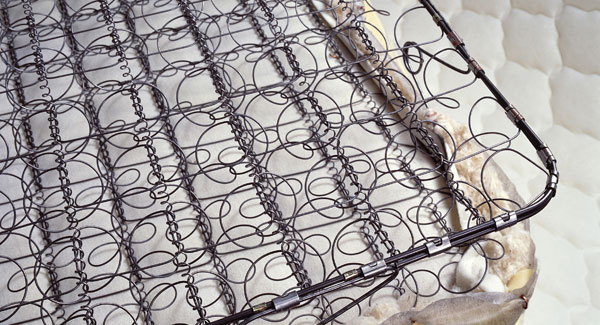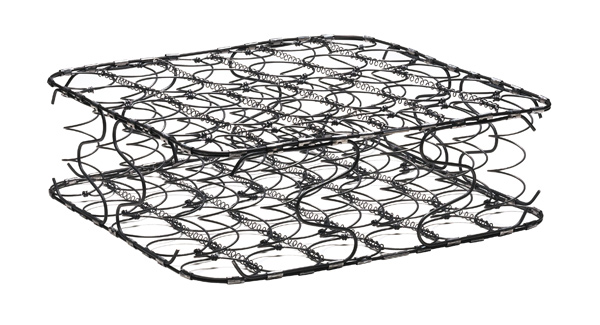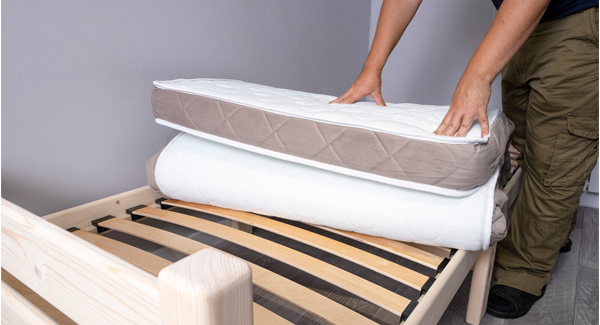Home » Mattress types » What Is An Open Coil Mattress? Here’s What You Need To Know
What is an open coil mattress? Here’s what you need to know
Article navigation
- Published:
- Written by: Tony Brown
- Topic: Mattress types
An open coil mattress is made from a continuous wire wrapped around to create a series of coils. These coils are typically arranged in rows and connected together to form the spring unit. Coil springs tend to be commonly used in mattresses as they can be mass-produced cost-effectively by a machine. An open coil mattress will typically contain between 300 to 800 springs.
Open coil mattresses generally feel firmer and bouncier than other types of mattresses. Manufacturers can achieve different firmness levels by altering the thickness of the wire. The thicker the wire, the firmer the spring. Some open coil mattresses are zoned, providing proper spinal alignment and ensuring the heavier parts of the body, such as the shoulders, lower back, and hips, are correctly supported.
Open coil mattresses typically contain synthetic materials such as foam, fibre, and polyester, although natural fillings like wool are sometimes used in higher-quality models. Hybrid models combine open coil springs with memory foam, latex, or gel. They provide the perfect compromise for sleepers who prefer the feel of a sprung mattress with the comfort and cushioning benefits of foam.
As open coil mattresses are inexpensive to produce, they are a good option for those looking to purchase a mattress on a budget. They are a good fit for children or teenagers who may not require the same level of support as adults. Open coil mattresses are also ideal for occasional use in a guest bedroom.
As open coil mattresses are mass-produced, they are only usually available in standard bed sizes. Other types of mattresses offer more flexibility with sizing and bespoke options.
Is an open coil mattress good for couples sharing a bed?
Mattress shopping can be confusing, especially when almost every brand claims its products are the answer to a better night’s sleep. Bed brands often come up with fancy names to describe their mattresses to help them stand out from the crowd.
‘Miracoil’ is a term Silentnight use to describe their open coil mattresses. It features a hippo and a duck to promote their mattresses as suitable for couples of different weights and sizes.
However, movement is transferred across the entire surface in an open coil mattress. This means that sleeping partners will likely feel each other’s movements in bed. Open coil mattresses may also sag around the edges, making you feel like you’re falling out of bed if you sleep close to the edge. Some mattresses feature edge support to prevent this.
Pocket springs offer a good alternative to open coils. Each pocket spring moves independently, so sleeping partners are less likely to disturb each other when they turn in bed.
For couples of widely differing weights, a zip and link or split tension mattress where each person can have different mattress tensions may be a more suitable option.
Zip and link allow two single mattresses to be zipped together, creating a king or super king size mattress. A split tension mattress combines different tensions in one mattress. For example, soft support on the one half of the mattress and medium support on the other.
Is an open coil mattress good for back pain?
As movement and pressure are spread across the entire surface of the mattress, open coils offer minimal contouring and are less effective at supporting the entire body. There may also be less padding in the mattress, which may cause pressure around the shoulders, hips, and knees if you sleep on your side.
Some open coil mattresses are described as orthopaedic. The term orthopaedic is misleading. It suggests that the mattress has been medically endorsed and is good for a bad back when this is not the case. Orthopaedic is a marketing term that describes a firmer mattress, and a firm mattress isn’t necessarily good for a bad back. Unless you are a heavier person, a firm mattress can aggravate pressure points and contribute to back pain and poor quality sleep.
Pocket springs work independently of one another and contour to the body more effectively. Pocket springs often contain more padding offering greater comfort and cushioning. There are usually more springs in contact with the body providing better support.
Similarly, memory foam and latex mattresses contour to the shape of the body and are effective at relieving pressure.
How long do open coil mattresses last?
Most open coil mattresses should last between 6 and 10 years with the right care. Some may need replacing sooner, while others may last longer. The lifespan of a mattress is affected by its usage, build quality, filling quantity and quality, and how it has been looked after.
As open coil mattresses are mass-produced cheaply, they tend not to be as sturdy or durable as other types of mattresses. The construction is predominately carried out by a machine and therefore not completed to the same standards as a mattress made by hand.
Open coil mattresses often contain thinner layers of padding for comfort. These layers usually contain synthetic materials such as foam, polyester, and fibre pads. Synthetic fillings tend not to recover as well as natural fillings and break down sooner.
Should you turn an open coil mattress?
Most mattresses require turning. How and when you turn a mattress depends on the manufacturer’s recommendations.
Generally, you should turn your mattress once a week for the first three months of use, then once a month thereafter. Non-turn mattresses (which only have a single sleeping surface) should be rotated regularly from head to toe.
Turning your mattress regularly will allow the fillings in the mattress to settle evenly and minimise impressions. It can also help extend the life of the mattress.
Open coil mattresses tend to be lighter than other types of mattresses and are therefore easier to turn and manoeuvre.
Final thoughts
Open coil mattresses are a good option for those looking for an inexpensive mattress on a budget. However, higher-quality foam or pocket sprung mattresses are usually more comfortable and supportive.
Share this article

About the author
Tony Brown is the founder and creator of The Bed Consultant. His career in the bed industry began in 2002. After graduating from university with a degree in Business Administration, Tony joined one of the largest independent furniture retailers in the UK as a bed consultant. Tony has helped thousands of customers find the perfect mattress.






